This summer, contrary to all previous plans and imagined agendas, I’ll be teaching an ecclesiastical embroidery class twice a week. I shouldn’t really call it a class. It involves one person, to whom I couldn’t say no. I’m glad of it – even though I hadn’t intended to teach at all this summer, a regularly scheduled meeting time twice a week is a great mainstay when it comes to keeping a structured schedule. So, I succumbed, and the first step in preparation for the class was the design process.
Before entering that process, I considered a few things: 1. What does the student already know? 2. What does the student want to learn? 3. What is reasonably achievable in the time that we have? 4. What are the various approaches we can take to reach our goals? 5. Of those approaches, which makes the most sense?
Next, I dug out my Ecclesiastical Stuff box.
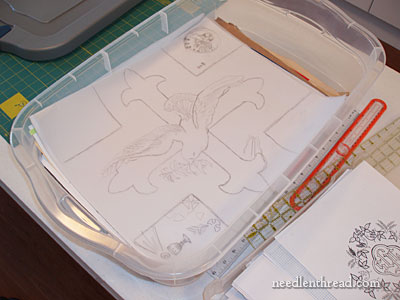
This is just a plastic tub where I keep all kinds of drawing paraphernalia relating to church embroidery that I’ve collected, that might give me some ideas.
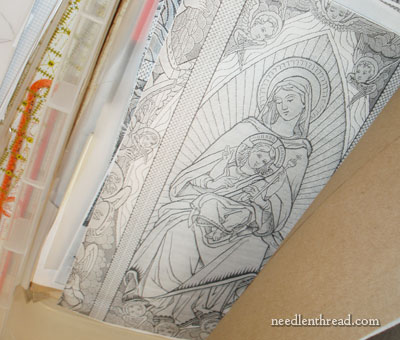
Deep within the box there are some photocopies of old vestments. Yes. Photocopies! They’re from a set of woven cloth-of-gold vestments from late 1800’s, that were displayed (and won prizes) at the World Fair. The cloth of gold was woven with red thread to create the designs on the vestments, and the cloth was woven to fit the pattern of the vestment, telling the story of the life of Christ, from nativity to the resurrection. It’s a magnificent set. I expressed interest in it to the priest in charge of the sacristy where it is housed. A couple weeks later, full photocopies of the entire set arrived in them mail! He had literally placed the set on a large bed photocopy machine and photocopies every element of the set! This happens to be one of my favorite design treasures…
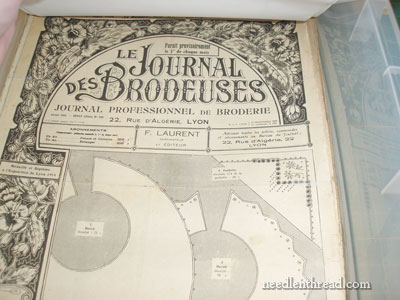
There are also different old needlework journals in the box. Lots of these old journals feature ecclesiastical designs, so I’ve separated out the ones that do, and stored them in this box.
It’s always helpful to have design sources on hand for ideas, so I started shuffling through the box for anything that might spark a notion for this project.
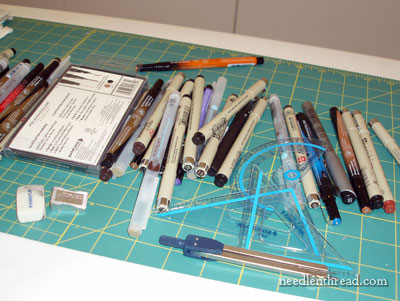
Then there’s the haphazard collection of tools – lots of drawing pencils and pens, a protractor or two, a compass, precise rulers, and a Really Good Eraser, which is my most-used tool.
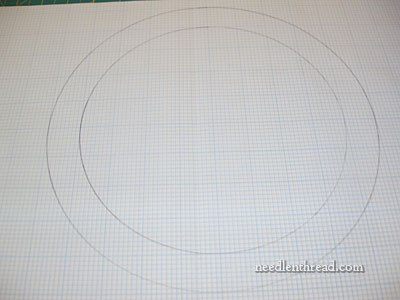
I work on graph paper, 8 squares per inch, and specifically, it’s vellum, so it is semi-transparent, which works well for tracing.
My student wants to learn more traditional techniques in ecclesiastical needlework, as seen on old vestments. Specifically, she wants to learn goldwork and silk shading, and she wants to learn it by working on an element that she can actually use on a vestment. Old vestments are often either fully embroidered (whoa, Nelly – that’s too much!), or they have a large embroidered cross on the back (still too much!), or they might just have an embroidered “medallion” that is placed at the intersection of the transept and pillar on the cross on the back of a vestment. Yes, a medallion is something more manageable.
I began with a circle. The medallion will be treated like an appliqué when it is finished. It will be cut out of the fabric and applied to other fabric. There are other shapes that are used for medallions, but the circle is pretty basic and it is easy to appliqué, so I started there.
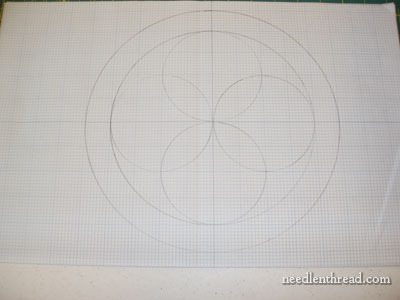
On this type of church embroidery piece, the framework of whatever final design will go in the center of the medallion is usually symmetrical. And that comes in handy in the designing part, but it can become downright tedious in the embroidery part. Symmetry lends to repeated design, especially for the elements that will adorn the framework for whatever goes in the middle of the medallion. Embroidering the same thing repeatedly can be … well, boring. But at the same time, it’s a good learning experience, because the repetition lends to improvement of technique as the piece goes along.
Anyway, the point is, the framework on these types of things is generally symmetrical and made up of repeated elements.
Never underestimate the power of a good compass when working on this type of thing! I Love My Compass.
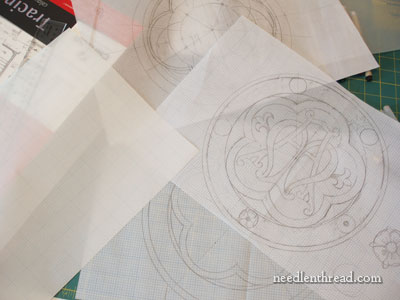
Even though I started off with a kind of “quatrefoil” design in the middle of the circle, it eventually evolved into a “cinquefoil” design, with five scallops. This is when a good protractor comes in handy. To get the scallops right, a line has to be marked off every 72 degrees. If you guesstimate something like that, the finished design, which should look symmetrical, may end up slightly “off” – and you will forever notice it, and it will drive you nuts! (Trust me, I’ve done it!)
So, about five starts and stops later, a design was starting to develop.
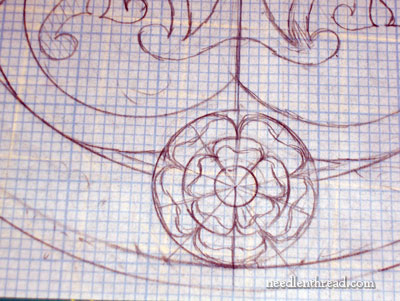
Repeating the cinquefoil element throughout the design, I decided to work in five stylized, Tudor-ish roses (a typical element in ecclesiastical embroidery). They have five petals in each of two rings. I figured this would be a good element for silk shading.
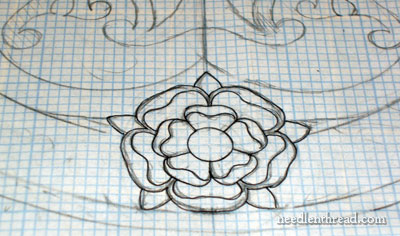
After drawing the rose, I inked it in and cleaned it up a bit, to see it more clearly. I like it. I’ll probably keep it.
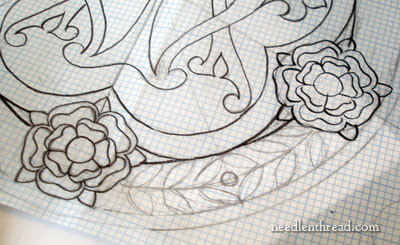
I repeated it in the next scallop point, and sketched in a possible filler design between the two roses. I’m not 100% sold on this – the advantage of leaves would be another opportunity for some silk embroidery and some color, but I think I still need to work out a few different ideas here that are joggling about in my head.
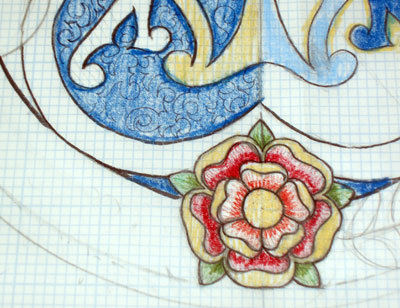
Finally, in a Very Basic Way, I globbed in some really sloppy color with Prismacolors. The background of the design above, I split into two, to test two different color options. I’m debating the color of the background. If we work this on a light ground fabric, the background around the central monogram would be light. But there are lots of possibilities for ground fabric for this type of design: velvet is a possibility, and there are some gorgeous blues out there; or the design can be worked on linen and completely embroidered, including the background; or the design could be worked on linen, and the background of the center part could be appliqueéd velvet – or maybe appliquéd silk in a darker color…. These are things that are swashing about upstairs in my head, but I haven’t arrived at any set conclusion.
Today, though I will give the ground fabric much more thought, while sifting through thread types and thread colors and metal threads. Incidentally, the design right now is about 9.5 inches in diameter, and I’ll be reducing this to 8″. So all in all, the medallion is “small” – but if you consider the amount of work that will go into it, if it is fully embroidered, it’s going to take some time to get those 8 inches covered!
And there you have my haphazard approach to design, and my progress to this point. I’m looking forward to sharing the development of this project with you. It’s my “Big” summer project, but not my “Only” summer project – I’ll show you what else I’ve got lined up, later this week!
Enjoy the day!
If you’d like access to all the tips and techniques discussed in the Medallion Project, including complete coverage of the Tudor-Style Rose, conveniently collected in one document, interlinked, referenced, and indexed, why not add the Marian Medallion Project e-book to your library? It’s packed full of all kinds of embroidery tips for undertaking a project like this, all in a convenient electronic format for easy searching.







Thank you for sharing your design process. It is amazing to me how your original 4 circles kept evolving until you had your completed design. I wish I lived close enough to be a part of your tiny class, but New York is too much of a commute. I look forward to seeing the steps of this project.
It’s great to see your design process, and it’s not haphazard at all. Most advice on designing seems to concentrate on sketching and experimenting, so it’s so good to see someone else taking an almost engineering drawing approach with graph paper, rulers, compasses, etc. I couldn’t manage without them!
You should consider an online class for this. If you do please sign me up! Your design looks beautiful!
G’day there Mary,
I think your heading should be ‘Haphazard IS Best’. I’m going to love being in this class. That rose is tantilisingly beautiful and very ‘just-hafta-stitch-itable’. The process of arriving at the design is intriguing. Thanks for all the info and photos.
Cheers, Kath.
I think you have more talent in your little finger than I do in my entire being! God uses you to bless me.
Dear Mary
The design process sounds complicated but it looks beautiful and I can’t wait to see the progress and the finished piece. I also wish I lived close enough to be involved in the class your stutdent is lucky to have a 1 to 1
sorry hit submit before I finished the email. Your student is lucky to have a 1 to 1 with you and maybe you should consider this for the online classes.
Regards anita
Wish I were in your area “Mar”….
I’d surely love to attend
Judy in Pittsburgh 🙂
Thank you for sharing this! I love to see how you work; you are an inspiration for me. Where do you get the vellum graph paper? What a great idea!
And what brand is your Really Good Eraser?? I am much in need of one that does not smudge & erases everything cleanly.
You should be teaching at EGA!!
Blessings to you!
Laurie
Oh, my!!! Thank you for taking the time to let us into your design process. Your talent is breathtaking. When I first subscribed to your blog it was for “eye candy”, but now I HAVE to learn this art. I know it will take me a lifetime, but oh, what a time! Thank you again! (Now, off to pray for internet service that doesn’t cost an arm and a leg so I can download all of your fantastic lessons!!!)
Your new student is a blessed lady!!
I also would like to see this as a class or a stitch along.
You are very talented.
Hi Mary,
Thanks for the peek into your design process! I thought it was well organized, not haphazard at all. I like your engineering approach to the process, and your Tudor rose is lovely!
HI Mary, thank you for taking us through the thought processes and drawing processes that are involved in making up a design.
I have a question. Shortly I will be sending away for a booklet to start one of my certificate courses. I had an idea to make a surface embroidery pattern from a painting. I know I should seek permission from the artist, but how do I find contact details for the artist. I have used the Google search engine three times to find a personal contact page to no avail. :/ What do I do know, other than find something else to make a pattern from??
Hi, All – Thanks very much for your comments and input on the design process! I’ve made a couple adjustments, but not too many…
Marian – You’re right; if you can’t track down the artist, you’ll have to find something else. Google isn’t the best source for personal contact information, though. The best source is the yellow pages, directory assistance, and your telephone! Call art galleries or museums that display the artist’s works and see if you can get contact information for either the artist or the artist’s agent. (I’m assuming it’s a contemporary artist who’s still living – so art galleries would probably be your best bet.) Hope that helps! ~MC
Dear Mary,
You’re absolutely right about the protractor. It’s impossible to achieve that kind of symmetry without being mathematically precise. A protractor, a set square, good rulers showing inches (divided into 32, 16 and 8) and millimetres, and a compass are very much part of my embroidery box(es). When I first took up needlework, I regretted very much having given away my mathematical instruments case after University!
I look forward to seeing your progress on this piece.
Shanti.
I have no idea why it put a smiley face instead of 8. That’s what it should be, but isn’t!
Mary;
Completely off topic, but I just watched a movie “Curse of the Golden Flower”, a Chinese movie where the main character is shown embroidering chrysanthemums. I thought you might be interested.
Thanks, Karen! I’ll look it up! I’m always interested in movies and books where needlework or related things show up. Right now, I’m reading again Tim Severin’s book, “The Brendan Voyage,” where flax, flax thread, the properties of linen, and stitching through leather were a big part of their preparation for their journey. Sure, it was only a relatively minor section of the book, but it’s what originally sucked me into reading it, and I’m so glad it did! So, definitely – thanks! I’ll look it up! ~MC
Mary, thanks for sharing your design process, and count me in for a class on ecclesiastical embroidery! What a great idea!
Carla
This is actually my favourite part of the process (a reason why I’ll never be a big one for kits).
The design decisions, the considerations of materials, and where, the colours ….. great fun!
Hi Mary,
I recently subscribed to your blog and I am beyond inspired and having a great time here! I am learning so much from you and this place feels like I am coming over to visit a friend. You help keep me motivated to keep my projects going and there are so many of new things I have found here that I want to try!!
The reason I am posting here is because I saw this post the other day and I saw the beautiful vestment photocopy of Mary that the priest gave to you and my gosh, I am taken with the beauty of it!
I am still a novice embroiderer, learning all the time and now transferring my own designs to embroider too. I used your tissue transfer basting technique and it has worked awesome!
This might be completely off base to ask and I fully understand if you say no. Is there any way that I would be able to have a PDF on your site or however it would make sense, to be able to have a copy of those BEAUTIFUL vestment patterns?
I would use it only for my own use. I am not at your level of stitching yet but can manage to make something pretty that my family is impressed with lol.
So far I have looked on the web and have found no patterns that are anywhere as beautiful as the one on that you showed us with Mary on it.
I am totally in love with it and would like to attempt to make it. I know that you received the copy under very special circumstances so I don’t really expect to be able to use it, but I figured that if I never asked than I would never know!
I love your site please keep up the good work!
Know that we who visit really enjoy what you are doing here and you have made so many techniques and styles that I had never even heard of before- ( I used to only cross stitch with pre-made kits from Michaels). My gosh my entire stitching world has exploded with such fun inspiration and possibility!
Thank You!
PS- Sorry this is so long and full of run on sentences!
Much respect,
Mindi Hammerstone
Hi, All! Thanks for your comments! This is actually a great part of the whole embroidery process for me…. I like this part better than setting up the actual project, anyway!
Hi, Mindi – I may very well turn those designs into embroidery patterns – that’s been my plan ever since I received them. I’ll see what I can do, and when! Thanks!
~MC
Thank you Mary for the response 🙂
If you ever do make those available I would pay you of course 🙂
I know you are busy and I will quit bugging you about them.
Thank you again for this wonderful site!
Mindi